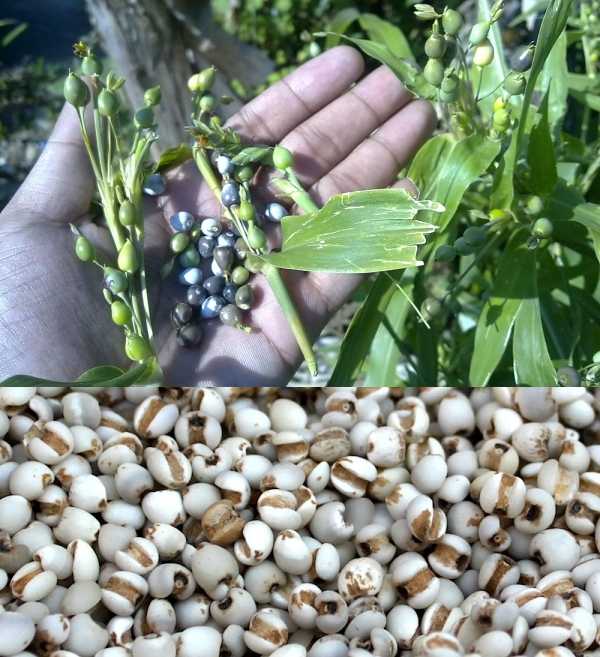Unknown to many Filipinos, Adlai also called Job’s Tears (Coix lacryma-jobi L.) belongs to the family Poaceae or the grasses, the same family to which wheat, corn, and rice belong. But unlike weeds, the stem of adlai could grow from 1 to 3 meters tall (from 3 to nearly 10 feet). The grains, which come in white or brown, in some instances, are spherical in shape and have a groove at one end, become the source of (staple) food of many native people particularly in the highlands.

According to the Bureau of Plant Industry, the leaves are 10 to 40 centimeters long, 2.5 to 4 centimeters wide, with the base broad and cordate. The spikes are 6 to 10 centimeters long, erect and peduncled, while the male spikelets are about 8 millimeters long.
Grains are usually harvested 4-5 months after sowing. Grains are separated from the stalks through threshing and, like rice; seeds are first sun dried before milling.
Uses and Benefits
As food source, Adlai is as versatile as rice. It can be cooked and processed as main ingredient for the all-time rice-based kakanin such as maja blanca, sinukmani, champorado, polvoron, and turones de adlai to name a few.
It has a pleasant mild flavor making it a good ingredient in soups and broths. The grain can be ground into flour and used to make breads, pastas, and porridge. The pounded kernel is also made into a sweet dish by frying and coating with sugar. It can also be husked and eaten as it is just like peanuts.
A tea can be made from the parched seeds while beers and wines are made from its fermented grains. Coffee or tea is made from the roasted seed.
Adlai has the highest food energy content (356 kcal) compared to corn (135 kcal), white rice (110 kcal) or brown rice (129 kcal). Hence, a person who ate a cup of steamed adlai for lunch is build to last a whole day’s work compared to those who ate rice. Adlai is also packed with other minerals including calcium (25 mg), phosphorus (43.5 mg), iron (5 mg), niacin (4.3 mg), thiamine (0.28 mg), and riboflavin (0.19 mg).
Adlai is commonly used as medicine in China as one of the most popular food herbs in diet therapy for painful and stiff joints. The crop is known to have anti -inflammatory, antihistaminic, muscle relaxant, fever reducing and sugar lowering properties. Some studies indicate that adlai has anti-allergic, anti-mutagenic, hypolipemic, and anti-diabetic effects.
Local Varieties: Kibua, Ginampay, Gulian and Tapol. Seeds are available at DA-NOMIARC, Dalwangan, Malaybalay City.
Production Management
Land Preparation
Apply manure and compost before plowing. Plow and harrow the area 3 times.
Planting
– Seed Preparation
Soak the seeds in pure water for 8 hours and incubate in 4 hours prior to planting.
– Planting Distance
Make furrow spaced at 90 cm to allow the plant to produce more productive tillers. Sow 2 seeds per hill at a distance of 60 cm between hills.
– Basal Fertilizer Application
Adlai is more productive when animal manure and compost are applied before plowing with an average yield of 2 tons/ha.
Cultivation and Maintenance
– Off-barring
At 3-4 weeks after planting, cultivate between rows to remove weeds.
– Thinning
At 2 weeks after planting, pull-out excess plants to maintain at most two plants per hill.
– Hilling-up
45 days after planting, hill-up within rows. Control subsequent weed growth by hand weeding.
Pest Management
Integrated Pest Management (IPM) practices were employed using Trichogramma evanescence to control Stem borer.
Harvesting and Post Harvest Operations
The crop can be harvested by cutting its branches and stems at one food from ground level at 120 days after planting.
Grains can be separated from panicle by threshing, and/or smashing (lambos). Dry grains to 14% moisture content (MC).
Adlai can be milled through rice and corn mills. It has a 60% milling recovery (depending on the varieties).
Ratooning can be done 2-3 times after harvest of the main crop.
Sources:
Velasco, A. (2010). Adlai seen as an alternative to rice and corn. July 2010 Issue (Vol. 11 No. 7)
Dela Cruz, R.T. (2011). Why eating adlai is good for you?. October-December 2011 Issue (Vol. 13 No. 4)
cagayandeoro.da.gov.ph

hello po, just to ask to very interesting question po for adlaih, if you are willing to export them here in europe? and if you want to have a person to contact from here?
san po nkakabili ng adlai flour?
nandito sa bukidnon mam
Paano po ba ang process.. My almost 12 hectares kmi na lupa..
Saan po kaya available ang buto ng adlai?
Need ko lang po sa thesis. Thanks! 🙂
Saan po pwede makabili ng adlai seeds?..gagamitin ko po sana sa thesis ko…salamat po!
I can't accept that authors of such writing don't bother to give information on where to buy the things they are writing about, that is a most disappointing mentality of such authors: the are always living in the air while writing about things which are not in the air but have to do with the stomach.
saan po nakakabili ng adlai?
may seeds po ako ng adlai kung gusto mo etx mo ako eto num. q 09062122238
sir san ba pwde maka bili ng seedling ng ADLAI pls give me info .. my location in Bayugan agusan del sur pls email me [email protected] … interested po ako mag tanim yan i have 5 hectars .
thanks po,
marie
sir san ba pwde maka bili ng seedling ng ADLAI pls give me info .. my location in Bayugan agusan del sur pls email me [email protected] … interested po ako mag tanim yan i have 5 hectars .
thanks po,
marie